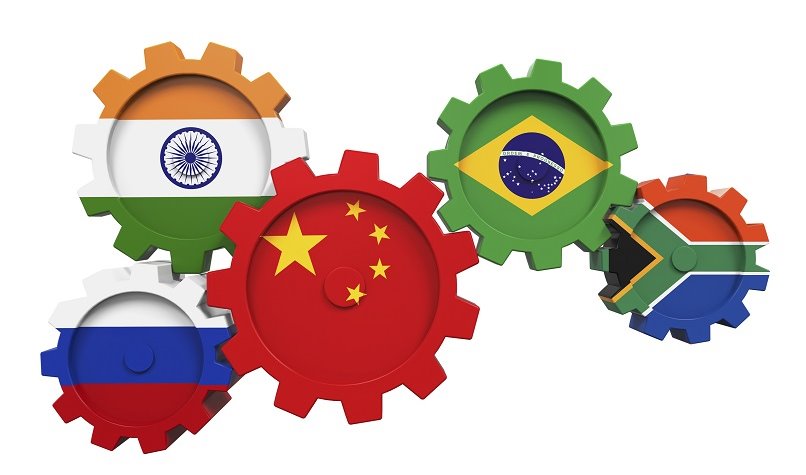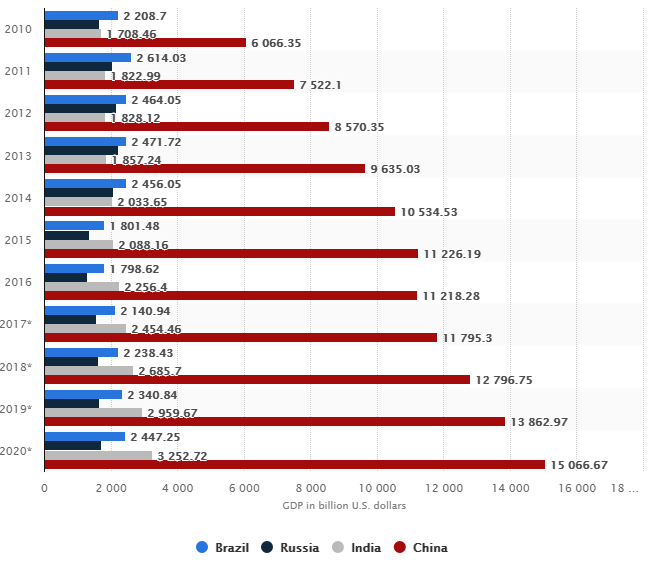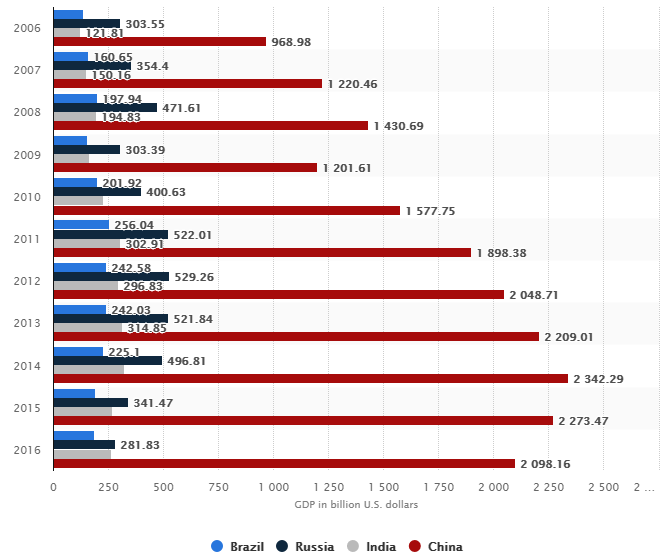BRICS is the acronym for a group of five major emerging national economies, namely Brazil, Russia, India, China and South Africa. The latter joined the group in the year 2010. The BRICS members are all developing or partly newly industrialised countries. However, the main characteristics of all five nations are their large, fast-growing economies as well as a significant influence on regional and global affairs. To say that, all of the nations are also part of the global community G-20. The five BRICS countries represent almost 3 billion people, with a combined nominal GDP of USD32 trillion (30% of the global GDP), and an estimated USD4 trillion in combined foreign reserves. The numbers mark a growth by about 60% percent from the formation of the group


Originally, the BRIC concept was created by Jim O’Neill in 2001, an economist from the UK working for Goldman Sachs. His thesis was that the four BRIC countries, Brazil, Russia, India and China, which are accounting for more than 25% of the world's land coverage as well as 40% of the world's population with growing tendencies, are likely to become part of the most dominant economies in the world by the year 2050. The thesis can be backed up with a 2017 ranking by PwC, analysing what is likely to be the world’s most powerful countries in 2050.
According to the South African Government News Agency, the trade between the BRICS countries has increased by around 70% over the last years from 2009 to 2017, demonstrating the benefit of the agreement by a group of nations, that has contributed more than half of global economic growth over the past decade.
On recent agendas in meetings located in Shanghai and Goa, India, the trade representatives of the emerging nations have discussed to improve their relations in service trade, e-commerce, intellectual property rights protection as well as investment promotion.
The combined GDP of all member in the BRICS group made up 23% of the global GDP in 2016, which represents an impressive growth from 10 years ago. However, the share in the global trade was only 16% in the same period and the scope of outbound investment even was fewer with 12%. These numbers show there is a great potential for the five nations to improve their investments and trade relations in the future to be really recognized as a major power in the world economics.
Gross domestic product (GDP) of the BRIC countries from 2010 to 2020 (in billion U.S. dollars)

Source: Statista
The five countries have repeatedly announced to strengthen their investment possibilities and deepen the trade relations in order to enable beneficial economic growth for all partners. The BRICS nations have also announced to work closer together in fighting protectionism in the global trade order, which is slowing down the development of export orientated firms.
In some areas, great achievements have already been made. For example, the share of protectionism for all BRICS members was already reduced remarkably in the first half of 2017.
Furthermore, a New Development Bank worth $50 billion, which has equal capital contributions from the five participating economies, was launched in Shanghai in 2015 to provide an alternative funding source to the World Bank and establish a foothold to reshape the global economic order.
Still many problems and challenges
Even a lot of progress in the trade relationship has been made, the nations are still facing problems and disagreements which are slowing down a fast growth and recognition as a major power in the World Trade Order. China and India, for example, have a border dispute in the Himalayan region, which is poking distrust between them. Economically, the trade turnover of the two fastest growing economies has even declined in 2016 by 1.7%. Also, India is the major nation that signed anti-dumping duties against Chinese products, even surpassing the USA in the number of unfair trade cases in 2016.
South Africa is affected by a decline in the demand for raw materials, the major exporting products of the country. The nation is also in a recession currently, opposing the economic trend of the other members of the group.
Brazil’s economy is suffering a recession currently. Overshadowed by corruption scandals, the country furthermore faces political instability and reduced investment flows. Brazil is set to suffer a decline of 3.5 percent in its GDP growth in 2016, according to the International Monetary Fund, which also foresees no growth for 2017. Already in its second year of recession, this marks the worst recession for the country in a century.
Something, that the other BRICS member is complaining about China in the group is, that currently the trade relations in the group are heavily tilted in China’s favor. After all, the world’s most populated country was the largest trading partner for the other group members in 2016. Looking the other way around, India, Russia and Brazil only ranked 13th, 14th and 15th on China’s trade partner list, with South Africa even further behind.
Also, reasons for the lack of trading integration among the BRICS compared to trade unions like the EU can be found in the geographical distance, and the lack of import and export matching in terms of supply and demand. That is, the goods they each require and produce are too similar. Both countries lack a broad industrial base, and instead, rely on the production of less sophisticated goods for sale in emerging markets. Only in some areas of exports can they compete on a global level.
And this lack of trading integration among the BRICS group is reflected in the statistics. Looking at the list of India’s top trade partners, China is number one, South Africa lies way down at number 22, and Russia and Brazil do not even feature. As they compete with China for trade with key emerging markets, the other BRICS must each plot their own individual course. Clearly, for Brazil and India, the need to develop and diversify their own trade is a must for long-term economic security.
The outlook
While the trade relationship within the block of BRICS may continue to strengthen following the growth of their economies, China’s most important relationships will remain with the USA., Europe and the neighbouring nations of Asia. After all, China’s booming economy and global trade are mainly tied to the global supply chain of many huge enterprises, where the other members of BRICS don’t have a sufficient role. Furthermore, the Chinese imports from the other nations are mostly raw materials, like agricultural products from Brazil, energy products from Russia, and wine from South Africa, which does not have a great value and can fluctuate easily in price and value.
Export of goods by the BRIC countries from 2006 to 2016 (in billion U.S. dollars)

Source: Statista
According to PWC, the members of the BRICS group will be among the most powerful economies by the year 2050. It determined the ranking by showing the 32 most powerful countries in 2050 measured by their global gross domestic product and purchasing power parity. The report states, that South Africa is likely to be the 27th most powerful country in terms of the economy by 2050. Russia is likely to climb to the 6th rank, surpassed by Brazil on rank 5. India might be the second most powerful economy, while will be the global leader.
It is also worth noticing, that more emerging countries have given hints on joining the group to take part in the beneficial partnerships. Examples of those countries are Egypt, Mexico, Indonesia, and Thailand. If countries like these will join the group in the future, the power and influence will be even greater, since they will also belong to the top economies by the year 2050. According to the report by PWC, Indonesia is likely to become the 4th largest economy behind the USA, while Mexico could rank the 7th.
One focus of future trade relation between the members is the development of e-commerce, according to representatives of all nations from the group. The members want to deepen the economic interconnectivity and boost the investment inside the group, which is currently only 6% of the total outbound for the countries combines. Member states have reached consensus on giving a higher priority to e-commerce. They even decided to establish an e-commerce working group for the BRICS nations and start the collaboration process right away.
It is not a surprise that the initiative is coming from China, seeing the fact that China’s e-commerce market accounts already for 40% of the global share. Therefore, the country offers the other member to share the experience and help them in platform building, digital payment systems, and logistics.